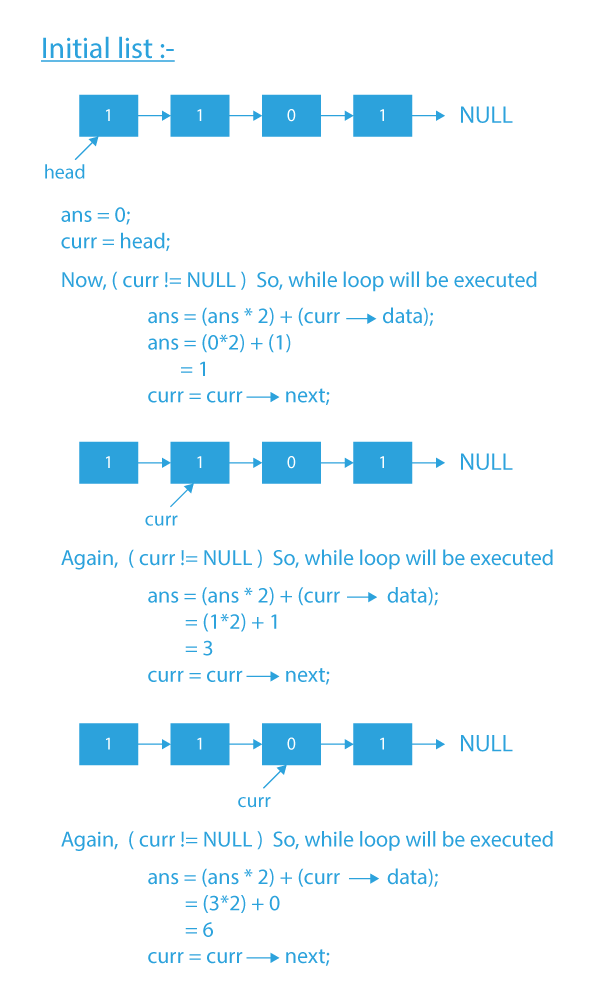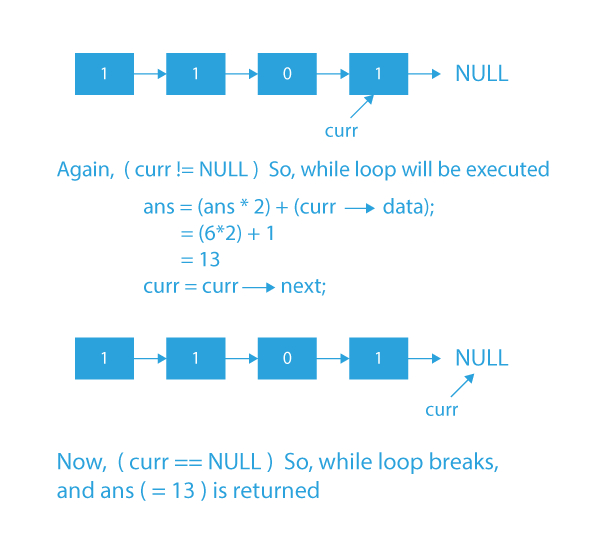In this article, we will discuss the decimal equivalent of a binary linked list. For converting a number from binary to a decimal using the positional notation method, we multiply each digit of the binary number with its base, (which is 2), raised to the power based on its position in the binary number. Practicing a linked list plays a very important role in the interviews. Having a good grasp of Linked Lists can be a huge plus point in a coding interview.
Problem Statement
We will be given a Binary linked list, i.e, a list where each node will be having either 0 or 1 as its data, and we need to find its decimal equivalent.
Problem Statement Understanding How To Obtain Decimal Equivalent Of Binary Linked List
Let’s try to understand the problem with the help of an example:
If the linked list given to us is 1→1→0→1→NULL
- According to the problem statement, we need to find the decimal equivalent of the given binary list.
- We can see that the binary equivalent of the given list is 1101.
- Now, on converting this binary equivalent 1101 into decimal, we get 13.
- So, the output will be 13.
Let’s take another example.
If the linked list given to us is 1→1→0→1→0→1→NULL.
- In this case, the binary equivalent of the given list is 110101.
- Now, on converting the binary equivalent 110101 into decimal, we get 53.
- So, the output will be 53.
At this point, we have understood the problem statement. Now we will try to formulate an approach to this problem.
Before moving to the approach section, try to think about how you can approach this problem.
- If stuck, no problem, we will thoroughly see how we can approach this problem in the next section.
Let’s move to the approach section.
Approach For Converting Into Decimal Equivalent Of Binary Linked List
Our approach will be straightforward:
- We will iterate the list from starting and accumulate the result in a variable.
- While we move through the list, the position of binary numbers that have been encountered till now in our result shifts by one to the left.
- So that’s why we will multiply our result by 21 (as there is a shift by one position) and add the current position’s data.
- Finally, we will be left with a decimal number, which will be the final decimal representation of our binary list.
Algorithm For Converting Into Decimal Equivalent Of Binary Linked List
- Initialize an ans variable by 0 and a curr pointer by the head of the list.
- Run a while loop till the curr pointer is not NULL.
- Every time inside the loop, multiply the ans by 2 and add the curr->data in ans.
- Move the curr pointer by one node.
- Return the ans after the loop breaks.
Dry Run For Converting Into Decimal Equivalent Of Binary Linked List
Code Implementation Of Obtaining Decimal Equivalent Of Binary Linked List
#include<stdio.h>
#include<stdlib.h>
#include<stdbool.h>
struct Node
{
bool data;
struct Node* next;
};
/* Returns decimal value of binary linked list */
int decimalValue(struct Node *head)
{
// Initialized result
int res = 0;
// Traverse linked list
while (head != NULL)
{
// Multiply result by 2 and add
// head's data
res = (res << 1) + head->data;
// Move next
head = head->next;
}
return res;
}
// Utility function to create a new node.
struct Node *newNode(bool data)
{
struct Node *temp =(struct Node *)malloc(sizeof(struct Node));
temp->data = data;
temp->next = NULL;
return temp;
}
/* Driver program to test above function*/
int main()
{
/* Start with the empty list */
struct Node* head = newNode(1);
head->next = newNode(0);
head->next->next = newNode(1);
head->next->next->next = newNode(1);
int ans = decimalValue(head);
printf("Decimal value is %d ",ans);
return 0;
}
#include <bits/stdc++.h>
using namespace std;
class Node {
public:
int data;
Node* next;
Node(int d)
{
data = d;
next = NULL;
}
};
// This function will return decimal
// equivalent of a binary list
int binaryToDecimal(Node *head)
{
// Initialize 'ans' by 0
int ans = 0;
// initialize 'curr' by 'head'
Node* curr = head;
// run a while loop till 'curr' is not NULL
while (curr != NULL)
{
// multiply the 'ans' by 2 and add
// 'curr' data to it
ans = (ans * 2) + curr->data;
// move 'curr' by one node
curr = curr->next;
}
return ans;
}
int main()
{
Node *list = new Node(1);
list->next = new Node(1);
list->next->next = new Node(0);
list->next->next->next = new Node(1);
cout<<"Decimal Equivalent of the given binary list is: ";
cout<<binaryToDecimal(list);
}
class BinaryLinkedList
{
// Link list Node /
static class Node
{
boolean data;
Node next;
};
// Returns decimal value of binary linked list /
static int decimalValue( Node head)
{
// Initialized result
int res = 0;
// Traverse linked list
while (head != null)
{
// Multiply result by 2 and add
// head's data
res = (res << 1) + (head.data?1:0);
// Move next
head = head.next;
}
return res;
}
// Utility function to create a new node.
static Node newNode(int data)
{
Node temp = new Node();
temp.data = (data==1? true:false);
temp.next = null;
return temp;
}
// Driver code/
public static void main(String args[])
{
// Start with the empty list /
Node head = newNode(1);
head.next = newNode(0);
head.next.next = newNode(1);
head.next.next.next = newNode(1);
System.out.print( "Decimal value is "+decimalValue(head));
}
}
class Node:
def __init__(self, data):
self.data = data
self.next = None
class LinkedList:
def __init__(self):
self.head = None
# this function will return decimal
# equivalent of a binary linked list
def decimalValue(self, head):
# Initialized result
res = 0
# Traverse linked list
while head:
# Multiply result by 2 and
# add head's data
res = (res << 1) + head.data
# Move Next
head = head.next
return res
if __name__ == '__main__':
llist = LinkedList()
llist.head = Node(1)
llist.head.next = Node(1)
llist.head.next.next = Node(0)
llist.head.next.next.next = Node(1)
print("Decimal Equivalent of the given binary list is: {}".format(
llist.decimalValue(llist.head)))
Output
Decimal Equivalent of the given binary list is: 13
Time Complexity For Getting Decimal Equivalent Of Binary Linked List: O(n), where n is the number of nodes in the linked list.
This article will help you to understand how you can get the decimal equivalent of binary linked list. Converting a binary number into a decimal number is a simple process but for converting a binary linked list into a decimal linked list, you need to practice a lot on linked lists. If you want to solve more questions on Linked List, which is curated by our expert mentors at PrepBytes, you can follow this link Linked List.
FAQ Related About Getting Decimal Equivalent Of Binary Linked List
- How do you find the binary equivalent of a decimal number?
- How do you convert binary equivalent 10101 to a decimal?
- What is the decimal number of 11110?
The simplest way to convert a decimal number to a binary number is by dividing the given number repeatedly by 2 until we get 0 as the quotient. Then, we write the remainder in reverse order to get the binary value of the given decimal number.
2^4 * 1 + 2^3 * 0 + 2^2 *1 + 2^1 * 0 + 2^0 * 1 = 21. Therefore, the answer is 21.
16 + 8 + 4 + 2 + 0 = 30. This is the decimal equivalent of the binary number 11110.





